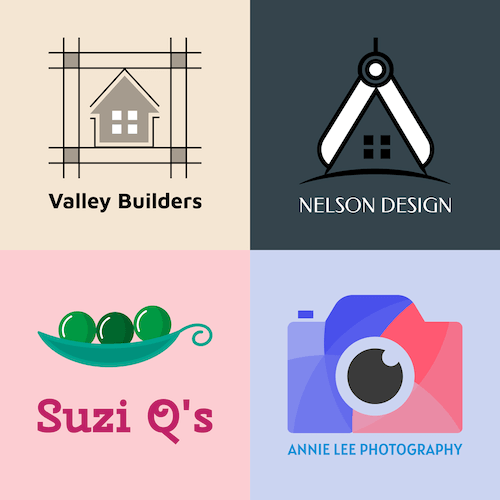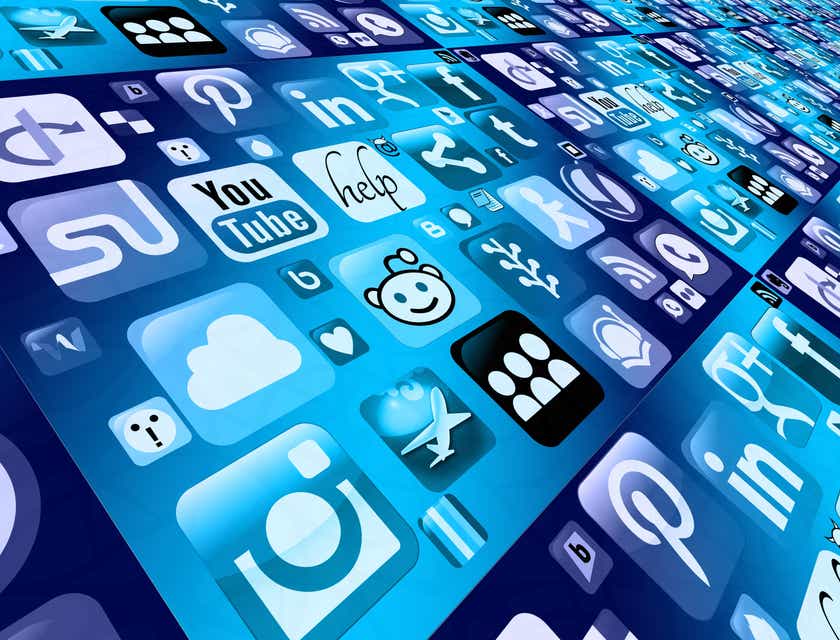
Enter your brand or company name to get started.
The 8 Most Common Types of Logos:
1. Monogram logos or lettermarks.
These logo types are typography-based and consist solely of letters, usually the brand's initials. Examples of these logo types include HBO, NASA, and IBM. There are also letterform logos, which are more minimalistic and typically consist of a single letter. Examples of these include Netflix and MacDonald's.
Monogram logos are simple and perfect for streamlining logo designs for companies with long names. They create a symbol that represents the company through their initials and, therefore, font and color choice are extremely important. However, this logo style can be difficult for start-ups, as they rely on repeated viewing for recognition.




2. Wordmarks or logotypes.
These are font-based logos that focus on the business name alone, such as eBay, Subway, Coca-Cola, and Google. For these logotypes, a succinct, distinct business name, rather than a long one, works best. Again, typeface and color choice are extremely important as they are used to capture the essence of the business.
Wordmarks convey the brand's attributes and can help with brand recognition. However, if they are not designed correctly, they can look generic, which will cause them to be forgettable for customers. Businesses may also have to change their fonts over time to keep current with design trends.




3. Pictorial marks.
Also known as brand marks or logo symbols, pictorial marks are icon or graphic-based logos that typically use a real-world image to represent a company, such as the logos for Apple, Twitter, Shell, or Target. These images are extremely representative and play on the company name, create a deeper meaning, or evoke an emotion.
The benefits of pictorial marks are that they are simple, extremely recognizable, and translate well when resizing for branding. However, these logos can be difficult to recognize without heavy marketing. For example, Twitter's logo started out with the name and the image, but when they became more popular, they dropped their name from the logo.




4. Abstract logo marks.
These types of logos include a specific style of a pictorial icon, which is typically an abstract geometric form. They are popular logo choices as they condense a brand into a single visual representation of a feeling or emotion related to what the company does. Examples include AirBNB, Nike, Pepsi, and BP.
Abstract logos are truly unique and use color and form to convey the meaning or emotion behind a business. They work particularly well for international businesses whose names can't easily be translated, as well as for large companies with various departments. However, these logos can be difficult to design well and are best left to professionals.




5. Mascots.
When used in logos, mascots involve illustrated characters that are mostly colorful, sometimes cartoon-like, and fun. They create a spokesperson (or character) for the brand and encourage customer interaction, which is great for marketing. Examples include the mascots for Kool-Aid, KFC, Pilsbury, and Mailchimp.
These logotypes really work for businesses that want to create wholesome, family-friendly atmospheres. However, they are not suitable logotypes for more serious, professional businesses, such as law firms or finance companies.




6. Combination marks.
As the name suggests, these logos are a combination of wordmarks or lettermarks with pictorial marks, abstract marks, or mascots. They can be designed side-by-side, on top of each other, or integrated together into one mark to create a distinct image that is easier to trademark. Examples include Doritos, Dove, Burger King, and Lacoste.
These versatile logos work as customers will immediately associate the business name with the pictorial mark or mascot. They can be used in various ways depending on the context; for example, just the word for business cards or just the image for social media. However, they can be busy designs that quickly overload visual branding.




7. Emblems.
Emblems are made up of a business name inside a symbol or icon, such as a badge, crest, or seal. The elements that make up the emblem are never isolated and have more detail than other logotypes. This also makes them less versatile as they are difficult to resize without losing readability. Therefore, it's best to have an uncomplicated design.
Emblems have a classic style with a traditional appearance that is bold, strong, and suitable for schools, government agencies, or organizations. They are used to increase the customers' feelings of brand quality, reliability, and longevity. Examples include Harvard, Starbucks, Harley-Davidson, and BMW.




8. Dynamic marks.
Dynamic marks are any type of logos that are adapted to suit the context they are used in. They are creative logos that are modified to fit a scenario, such as using a different style for social media versus print media, or to make a different impression on customers.
Dynamic logos work for businesses in media, entertainment, or creative industries, as well as for businesses that have different branches, such as FedEx. However, this logotype is not suitable for start-ups as the constant changes can affect the memorability of the logo. Some examples of dynamic logos include FedEx, Nickelodeon, AOL, and Google.









